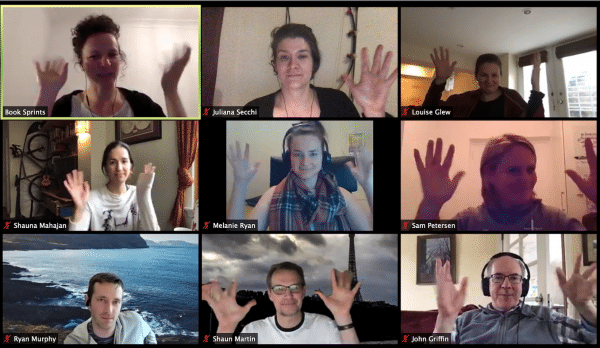We now do Virtual Book Sprints
Facilitating Virtual Book Sprints is our response to the new normal and the needs of our clients. Their need is to collaboratively and efficiently produce knowledge, some of it more urgent than ever.

Customizing the Book Sprint experience
Our team and our clients have been seeking ways to remain productive while keeping safe at home. We are used to traveling frequently to get together with groups of experts in one space, where we work intensely to produce a book in five days. Real-space collaboration was one of the principles we had always sworn by. Even before the global pandemic, we had been questioning whether we could reach similar levels of productivity and knowledge exchange in a virtual space. At the beginning of 2020, as part of our commitment to become a more climate-conscious business by reducing air travel, we had started exploring hybrid online-and-offline collaborative methods.
With the outbreak of COVID-19, it was no longer a choice. We would either have to wait it out or go fully virtual. Going virtual did not mean simply taking a process that works well onsite and mapping it onto an online environment. The whole Book Sprint process had to be revisited and re-designed. For this we turned to Sprint Lab which we founded in 2019 for designing atypical processes such as update sprints and curriculum design sprints. Using our Sprint Lab methods, we adapted our Book Sprint model to design different processes for different clients, some of them fully virtual, other hybrid formats. We spent time designing the virtual process with a specific selection of tools, facilitation techniques, preparations, time boxes, and adding mindfulness exercises to the mix to increase focus, even when working from home under often improvised conditions.
A short video on Virtual Book Sprints
From zero to book in 5 to 15 days
Some of our clients who had Book Sprints scheduled in the second quarter of 2020 had enough of a pressing need and adventurous spirit to test it out with us. They went through a virtual Book Sprint, resulting in books, written by a group of experts, remotely and online, in just a few days!
Red Hat’s OpenShift Security Guide
“Shawn Wells and I were the only team members that had participated previously in a Book Sprint and we knew the challenge that was ahead of us. We also knew that if any team could do it, it was going to be a Red Hat team. The key to success with this model is experienced and trusted facilitation, and excellent logistical support. Our Book Sprint facilitation team came through with flying colors. ” – Keith Basil, Senior Principal Product Manager at Red Hat
In April 2020 we facilitated our first fully virtual Book Sprint with Red Hat, and were thrilled that the OpenShift Security Guide was released for Kindle on May 8th on Amazon, where the book was ranked #1 new release in the system administration category. A number of technology companies like Red Hat, Cisco and VMware use Book Sprints to gather internal knowledge about complex solutions and produce a comprehensive overview for all their customers and teams. For them, good documentation is a powerful sales tool, increasing both the adoption of technology solutions and user satisfaction. Our clients tell us that along with the speed of production, the fact that the book has been written, reviewed and endorsed by five to fifteen of their key experts – the engineers, architects, developers, technical writers, marketing or sales people – also adds credibility to their products.
The Red Hat Book Sprint group was unusually large; 19 participants from different time zones. The goal was equally ambitious: to create a comprehensive guide to technical system configuration from a holistic infrastructure perspective. We designed a Virtual Book Sprint process that gathered all the content experts in the first week and facilitated conversation among them, guiding them to develop a structure and map out their knowledge. The group needed little time for decision-making, so we combined focused plenary sessions with breakout groups for writing in pairs. The group produced a lot, 55.000 words and around 50 diagrams. In a second week, a smaller team of participants worked through the entire text, refining the content, filling missing gaps, and making sure the book was accurate, coherent and readable.
Read about the Red Hat experience in the words of the organizer, Keith Basil.
Voting for the Book Cover from a set of cover options
WWF’s Systems Thinking Facilitation Kit
Not much later, we gathered online with seven participants from WWF to write a System Thinking Facilitation Kit. Large institutions, NGOs and multi-stakeholder projects like WWF, World Bank and USAID often use Book Sprints to demarcate a certain field of knowledge, for example to: define policy, communicate a thesis or capture practical experience from multiple contexts. Compared to our first Virtual Book Sprint, WWF’s topic required a lot more discussion but shorter and more concise content.
We designed a process that allocated ample time for developing a shared understanding and consensus across the diverse perspectives in the beginning of the Book Sprint. We chose five days of synchronous work with all the participants to brainstorm, outline, and draft all content. Over the next two months the draft will be tested with a focus group. The group’s feedback will be integrated during a second Sprint, onsite if travel restrictions allow, or online.

The final day of the first week with WWF
Challenges accepted
Of course there are challenges to shifting a process designed for in-person interaction to an online environment and we are rising to meet each of them with curiosity and creative solutions, as they emerge.
How to ensure committed presence at Virtual Book Sprints?
Book Sprints have a clear goal and unlike conferences and workshops, where the goal might be to network and exchange ideas, we produce a book together. In a typical Book Sprint, travel and budgetary restraints are involved and our client goes through a thoughtful selection process, putting together just the right constellation of contributors to get the book done. We recommend a maximum of 15 participants. In an online setting, the selection is more challenging for the organizer, since everyone on their team is technically available, online from home. There is also by now the expectation in online collaboration that everyone is always multi-tasking and can drop in and out of a process, based on their own schedule. As a result, participants don’t expect that they have to be 100 % present during a Virtual Book Sprint.
What we have learned is that we need to set expectations more clearly for the organizer and the participants and plan extra time before we start to prepare them for the Sprint. What we normally do on the first day of an onsite Sprint needs to be brought forward to a kick-off meeting, getting everyone fully onboard, ready to turn on out-of-office responses on their email, and ready to go.
How to encourage productivity and focus?
While video-conferencing is great for keeping people connected and working together, the issue of “Zoom Fatigue”, or the tiredness and stress that comes from the constant use of video conference tools, is real. For us this has meant accepting that while we can achieve excellent results and productivity with groups online, we cannot rely on the same daily schedules as we do onsite. We have extended the classic 5-day sprint into weeks with shorter days (between six and eight hours, depending on the group, their timezones and their familiarity with working remotely).
Alongside video-conferencing we make use of other tools to facilitate effective collaboration online. We’ve explored several tools that offer great support for brainstorming, consensus mapping, decision-making and book production. Visual collaborative tools allow groups to keep a record of what has been discussed in large or small groups and are crucial for ensuring that tasks are adequately monitored.
What gets lost though is a good part of the human element which our facilitator relies on. It can be more challenging to read group dynamics, follow participants’ lines of thought and create momentum. What we normally call an organic style of facilitation requires a more structured and explicit approach in this context. For example seeking clarifications, articulating consensus, visualizing every single decision, and scheduling progress reports at different points during the day. We find it useful to establish a shared agreement for how to engage in online discussions at the start of the Sprint, for example, keeping cameras on during group discussion, muting yourself when it’s not your turn to talk, using visual signs for soft approvals or disagreement and queuing comments or questions in the chat window.
Brainstorming on the book content
How to foster social connection?
At an onsite Book Sprint, the group works together, spends breaks and meal times together, takes walks, sometimes even stays in the same house together for the week. Online, we lose most of those connecting moments. The shared experience consists of the screen, each others’ voices and the evolving document. So we have been introducing a few new elements into the Sprint design.
One of our facilitators, Faith Bosworth, who also facilitates and teaches mindfulness for work environments with her company, Calm and Connect, designed and ran some sessions for us at the start of each day. She started the Sprint with a sound awareness exercise which helped create personal connection and highlighted the different contexts of all the participants. After this, the morning sessions were focused on the different phases of the Sprint, sometimes simply doing a go-round with the group and each person sharing something they wanted to celebrate with the group or a guided meditation to reflect on the intention of the book and personal motivation for the Sprint. The participants reported that these helped them counter the stress of getting the work done, and helped them refocus for the day.
On the technical side, we also set up social channels on Slack so that participants could have a space for casual conversations and since there were a few people who had pets at home, we invited people to share pictures of their pets. While we found it a challenge to create space for casual conversation on video, it was more natural in a smaller Sprint with just 7 people. People could make a cup of tea and just chat as if we were on a tea break onsite.
Virtual Book Sprints work and we are ready to do more
When we realized we really had to give Virtual Book Sprints our best effort, we also saw that we had already been preparing for this.
While some organisations have really struggled to adapt to remote working during this time, we were actually fairly used to it and had good systems in place. Although we spent the last ten years running Sprints in real space in different places around the world, we were at the same time working remotely with our own production team. Connected across at least 7 different countries and timezones from to Nicaragua to New Zealand, our book designers, illustrators, copy editors and project managers have to coordinate well and turn around tasks very quickly. Our internal online collaboration is aided by a good mix of tools including the collaborative book production platform Editoria, the collaborative design application Figma and the the open source chat software Mattermost. 
The tools are only half the story. Despite ever improving online environments, everyone is struggling with online meetings now. Making meetings stay productive and focused is tricky, both on- and offline. At Book Sprints, we have promoted the power of facilitation to make meetings highly efficient, effective, and even fun. And now we are happy to transfer those skills to online meetings, and adapt and expand our skillset where necessary.
Despite the challenges that come along with facilitating Virtual Book Sprints, we also see clear advantages. The one that stands out the most is the possibility to customize the sprint design individually to meet the needs of each client and their outcome. The virtual setting allows more flexibility with regard to time frames. We can stretch the process over several weeks, which in an onsite Sprint would hardly be possible. The Book Sprints process can be broken down into a mix of synchronous Sprint blocks where everyone comes together, and other more self-organized work phases with clear deliverables. We now also have the possibility to juggle the group constellation, for example bringing in experts to fill missing content gaps, conduct testing with the potential readers or gather external reviews.
Applying our online facilitation methods with an array of suitable tools, we have now completed several fully Virtual Book Sprints, and we are ready to offer them with confidence to other clients. See our info flyer on Virutal Book Sprints with all relevant information.
We are happy to discuss your idea.

